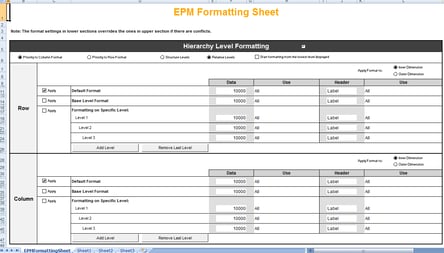The formatting strategy chosen for a report or input schedule is one of the most important decisions made in  development because it influences performance, complexity and the “fun factor” for development. I say this with humor because the report may take 4 hours to build and 8 hours to format! There isn’t room enough to go into all aspects of formatting in detail, however the understanding of choices we have is critical and can certainly influence the overall life cycle (maintenance and productivity).
development because it influences performance, complexity and the “fun factor” for development. I say this with humor because the report may take 4 hours to build and 8 hours to format! There isn’t room enough to go into all aspects of formatting in detail, however the understanding of choices we have is critical and can certainly influence the overall life cycle (maintenance and productivity).
The EPMFormatting sheet is used to format dynamic reports and input templates. It is an Excel sheet that can be copied and changed for multiple worksheets and reports. Dynamic formatting means the formats are applied to levels of a hierarchy, types of members or column and page axis dimensions.
Static reports can use any available Excel-based formatting such as: conditional formatting, number formatting, and text and cell formatting, indentations, word wrapping, and fonts. Anything and everything with native Excel formats can be done in a static report without the use of an EPMFormatting sheet.
There are situations, such as with using EPM’s copy range (EPMCopyRange())functionality, where EPMFormatting isn’t used. EPMCopyRange uses Excel-based formatting. People have attempted to blend both but ‘order of operations’ during refresh tends to interfere with results. You can use EPMFormatting for reports that are not using EPMCopyRange(). For instance if you have several reports on a tab you can use both methods, however cannot combine methods on a single report; it is either EPMFormatting or EPMCopyRange()
Related Blog Post: EPM Execute API - SAP BPC
Data Validation can also be a valuable feature to include to evaluate data inputs to ensure the input date meets criteria. This can be set up using EPMFormatting, Excel’s data validation, Cell-based formulas, conditional formatting, properties, or EPM’s API tools. The method chosen defines how the validation is carried out. For instance, we can lock a cell from being changed or we can block the user from sending data. Validation will influence design strategy, so have some idea what method will be used before building out the object(s).
There are many uses of formatting in making your reports and input schedules much more functional and visually appealing. For more details, contact Column5’s expert consultants today.
Related Content:
Blog Post: Useful Tips of Advanced Functionality in EPM10 Dynamic Formatting
Blog Post: SAP BPC Reporting Tips & Tricks
Blog Post: The Integrity of Data Entered into SAP BPC via Input Schedules
Blog Post: New Features of BPC 10.x Upgrades
Webcast: Taking your HR Planning & Forecasting to the Next Level with DarwinHCM and Business Planning and Consolidation
Darwin Modules are the next evolution in Starter Kits and RDS options. This session is focused on DarwinHCM and how this module can provide a high degree of value and benefits for Human Resource and Headcount Planning BPC Environments. DarwinHCM includes pre-built advanced input forms, report templates, business process flows and optimized logic/business rules that are designed to be deployed in as little as one week at a fixed price. We will walk through the sample business process flows and focus the demonstration on the process from the business user perspective.
Demonstration Highlights will include:
- Global Drivers and Setting
- Adding New Employees
- Transfers, Promotions and Terminations
- Real-Time Reporting & Analysis
 Author Bio:
Author Bio:
Deborah Silverman has been with Column5 Consulting for almost 5 years as a Senior Consultant. She is one of our most popular blog writers with her decades of software experience. She has assisted in hundreds of implementations and specializes in SAP BPC.












